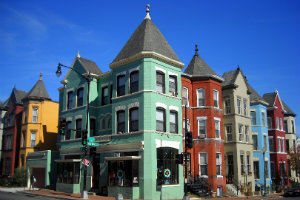Humanities
A Lens on Diversity in our Cities

Michael Bader is watching US cities and their suburbs change in real time.
Bader, an AU assistant professor of sociology, recently made headlines by studying demographics close to home—in the Washington metro area. Bader’s study, which focused on diversity, found that more than two-thirds of people who live in the region’s most diverse neighborhoods reported being extremely or very satisfied with where they live. People in diverse neighborhoods also felt that their neighborhoods were better than other neighborhoods.
The goal of the study was to investigate how DC-area residents experience racial diversity in their lives. The results revealed significant differences in their concerns about their daily lives, based on their race and income. Whites were slightly more likely to be “extremely satisfied,” but less likely to think that their neighborhoods have improved in the past five years. Blacks and Latinos were six to seven times more likely than Whites to fear arrest or feel anxiety about police questioning them or their loved ones. Latinos, more than other racial groups, fear crime in their neighborhoods. And households with children that had annual incomes of less than $30,000 were twice as likely as those making $150,000 or more to report that nonprofit organizations were not available to serve their needs.
Bader hopes that the study’s findings will make local policymakers aware of differences in the experiences of racial and economic groups, even among residents of the DC area’s most racially diverse neighborhoods. He hopes that this information will play a role in shaping future policies and programs.
Segregation and Resegregation
Bader joined American University’s Sociology Department and Center on Health, Risk and Society in 2011. He says that his research investigates the processes that perpetuate racial and economic segregation in American cities and the consequences of that segregation and spatial inequality on health disparities. Bader previously worked on the health of communities, particularly examining “food deserts,” and how not living near a grocery store correlated with major health issues and the disrepair of a neighborhood.
Now Bader is focusing on the changing demographics of US cities and suburbs. In early 2016, he co-authored a study published in Sociological Science, which revealed that cities across the United States are slowly becoming more segregated.
Bader examined more than 10,000 neighborhoods in Los Angeles, Chicago, New York, and Houston. He found that racially diverse neighborhoods—seemingly a sign of progress in racial equality—are actually segregating over time. And his findings suggested that even greater racial segregation will occur in US neighborhoods within the next two decades.
Bader sees one possible bright spot in the demographics of this shift, and it’s in the suburbs. “The most diverse neighborhoods in the metropolitan areas I’ve studied are in the suburbs,” Bader says, calling this trend “durable integration.” The reason, his research shows, is that Whites who move into multiethnic neighborhoods tend to stay, or at least move away at a slower rate than in the past when White flight was a prevalent response to neighborhood integration. “We found that while Whites who move to the suburbs will stay when Blacks and Latinos move in, they do not seek out racial integration.”
But overall Bader adds, “Our research finds that Whites are unwilling to move into neighborhoods that are heavily integrated. Over time this has resulted in a slow, but steady, racial resegregation in urban areas.” Further, Bader says, the economy is contributing to resegregation of some neighborhoods, and could eventually have the same impact on the suburbs. “As White families in racially integrated neighborhoods move out to downsize or take new jobs, they are unlikely to be replaced by White families. Black, Latino, or Asian families are more likely to move in—which leads, over time, to resegregated neighborhoods.” Bader believes that stabilizing these neighborhoods should become a policy priority.
Public Data Changing Research Methods
Bader’s research has been aided by the growth in open source or “big data”sources like Google Street View, which provides panoramic photos from positions along many streets in the world.
One of Bader’s most recent studies involved the use of Google Street View as a method of evaluating a neighborhood. The study found racial differences in exposure to physical disorder among older residents in four cities: New York, San Jose, Detroit, and Philadelphia. The public availability of data allowed a small team to record what used to require several dozen people on the ground in all four cities to accomplish. Though there are some drawbacks to Google Street View, like the time it takes for the site to update its photos, it is still a powerful and ever-evolving tool for data collection about neighborhoods across the nation.
What’s Next
Bader’s next project is highly ambitious—he plans on applying updated neighborhood scanning to analyze race and nationwide housing conditions. “Other research has shown that African American families tend to live closer to physical disorder than white families, even with comparable income and houses,” Bader explains. The project will analyze neighborhoods by demographics and then cross-reference the physical data with Street View imaging.
The project, huge in scope, is only possible in this time of open access data. It will collect a vast amount of information about American cities and their residents—and how they are changing through time. The end goal, however, is to analyze this information and make it accessible to policymakers and other stakeholders who can act on it to improve the lives of Americans.
